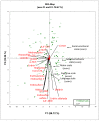Residue Levels of Organochlorine Pesticides in Breast Milk and Its Associations with Cord Blood Thyroid Hormones and the Offspring's Neurodevelopment
- PMID: 31018505
- PMCID: PMC6517872
- DOI: 10.3390/ijerph16081438
Residue Levels of Organochlorine Pesticides in Breast Milk and Its Associations with Cord Blood Thyroid Hormones and the Offspring's Neurodevelopment
Abstract
Previous studies have demonstrated that organochlorine pesticide (OCP) exposure has a negative impact on the neurological function of infants. Only a few reports have investigated the thyroid and growth hormones and their relationship to neurodevelopment after human exposure to OCPs, especially in the case of infants. Our goal was to determine whether breastmilk OCP residues were associated with negative impacts and/or alterations in the neurodevelopment of infants among specific southern Taiwanese mother-breastfed infant pairs. Our subjects (n = 55 pairs) were recruited from southern Taiwan between 2007 and 2010. The thyroid and growth hormone levels in the cord blood samples collected after childbirth were determined. The breastmilk was gathered within one month after childbirth for the determination of OCP levels using a high-resolution gas chromatograph with mass spectrometry, and the neurodevelopment of 10-12-month-old infants was examined using the Bayley Scales of Infant and Toddler Development®, Third Edition (Bayley-III). It was observed that 4,4'-dichlorodiphenyl-dichloroethylene (4,4'-DDE) (mean = 10.3 ng/g lipid) was the most predominant OCP compound in the breastmilk samples. At higher concentrations (>75th percentile), specific OCPs were associated with significantly lower levels of thyroid and growth hormones than at lower concentrations (<75th percentile). Significantly higher odds ratios (ORs) were observed for binary cognitive (OR = 8.09, p = 0.025 for 4,4'-DDT), language (OR = 11.9, p = 0.013 for 4,4'-DDT) and social-emotional (OR = 6.06, p = 0.01 for trans-CHL) composite scores for specific OCPs belonging to the lower exposure group as compared to the higher OCP exposure group. The five domain Bayley-III infant neurodevelopment outcomes were negatively associated with specific OCPs in the breast milk samples based on the redundancy analysis (RDA) test. Bayley-III scales, which include cognitive, language, motor, social-emotional, and adaptive behavior scales, could be predicted by 4,4'-DDT, endrin, endosulfan I, heptachlor, or heptachlor epoxide using multivariate linear regression models with adjustment for maternal age, pre-pregnant BMI, parity, and infant gender. In conclusion, although our study showed that postnatal exposure to breast milk OCPs may be associated with infant neurodevelopmental outcomes and that prenatal exposure, if extrapolated from breastmilk levels, is associated with changes in thyroid and growth hormones that may have effects on neurodevelopment, these associations are only suggestive; thus, further studies are recommended for confirmation.
Keywords: Bayley-III; breast milk; infant neurodevelopment; organochlorine pesticides; thyroid hormones.
Conflict of interest statement
The authors declare no conflict of interest with regards to this study.
Figures
Similar articles
-
Organochlorine pesticide residues in maternal blood, cord blood, placenta, and breastmilk and their relation to birth size.Chemosphere. 2013 Feb;90(5):1704-10. doi: 10.1016/j.chemosphere.2012.09.083. Epub 2012 Nov 6. Chemosphere. 2013. PMID: 23141556
-
Levels of organochlorine pesticides in human milk from central Taiwan.Chemosphere. 2006 Mar;62(11):1774-85. doi: 10.1016/j.chemosphere.2005.07.036. Epub 2005 Sep 12. Chemosphere. 2006. PMID: 16154617
-
Association between Organochlorine Pesticide Levels in Breast Milk and Their Effects on Female Reproduction in a Taiwanese Population.Int J Environ Res Public Health. 2018 May 7;15(5):931. doi: 10.3390/ijerph15050931. Int J Environ Res Public Health. 2018. PMID: 29735922 Free PMC article.
-
The association between prenatal exposure to organochlorine compounds and neonatal thyroid hormone levels: a systematic review.J Pediatr Endocrinol Metab. 2020 Jan 28;33(1):21-33. doi: 10.1515/jpem-2019-0336. J Pediatr Endocrinol Metab. 2020. PMID: 31851616
-
Pesticide residues in breast milk and the associated risk assessment: A review focused on China.Sci Total Environ. 2020 Jul 20;727:138412. doi: 10.1016/j.scitotenv.2020.138412. Epub 2020 Apr 13. Sci Total Environ. 2020. PMID: 32330708 Review.
Cited by
-
Relationship between Autism Spectrum Disorder and Pesticides: A Systematic Review of Human and Preclinical Models.Int J Environ Res Public Health. 2021 May 13;18(10):5190. doi: 10.3390/ijerph18105190. Int J Environ Res Public Health. 2021. PMID: 34068255 Free PMC article.
-
Effects of Organochlorine Pesticide Residues in Maternal Body on Infants.Front Endocrinol (Lausanne). 2022 Jun 9;13:890307. doi: 10.3389/fendo.2022.890307. eCollection 2022. Front Endocrinol (Lausanne). 2022. PMID: 35757428 Free PMC article. Review.
-
Exposure to Environmental Pesticides and the Risk of Autism Spectrum Disorders: A Population-Based Case-Control Study.Medicina (Kaunas). 2024 Mar 14;60(3):479. doi: 10.3390/medicina60030479. Medicina (Kaunas). 2024. PMID: 38541205 Free PMC article.
-
Association between pre- and postnatal exposure to endocrine-disrupting chemicals and birth and neurodevelopmental outcomes: an extensive review.Clin Exp Pediatr. 2024 Jul;67(7):328-346. doi: 10.3345/cep.2023.00941. Epub 2023 Nov 16. Clin Exp Pediatr. 2024. PMID: 37986566 Free PMC article.
-
Breastfeeding, pregnancy, medicines, neurodevelopment, and population databases: the information desert.Int Breastfeed J. 2022 Aug 2;17(1):55. doi: 10.1186/s13006-022-00494-5. Int Breastfeed J. 2022. PMID: 35915474 Free PMC article. Review.
References
-
- ATSDR (Agency for Toxic Substances and Disease Registry) [(accessed on 26 December 2018)];Toxicological Profile for DDT, DDE, and DDD. 2002 Available online: https://www.atsdr.cdc.gov/toxprofiles/tp35.pdf. - PubMed
Publication types
MeSH terms
Substances
LinkOut - more resources
Full Text Sources
Medical
Miscellaneous



